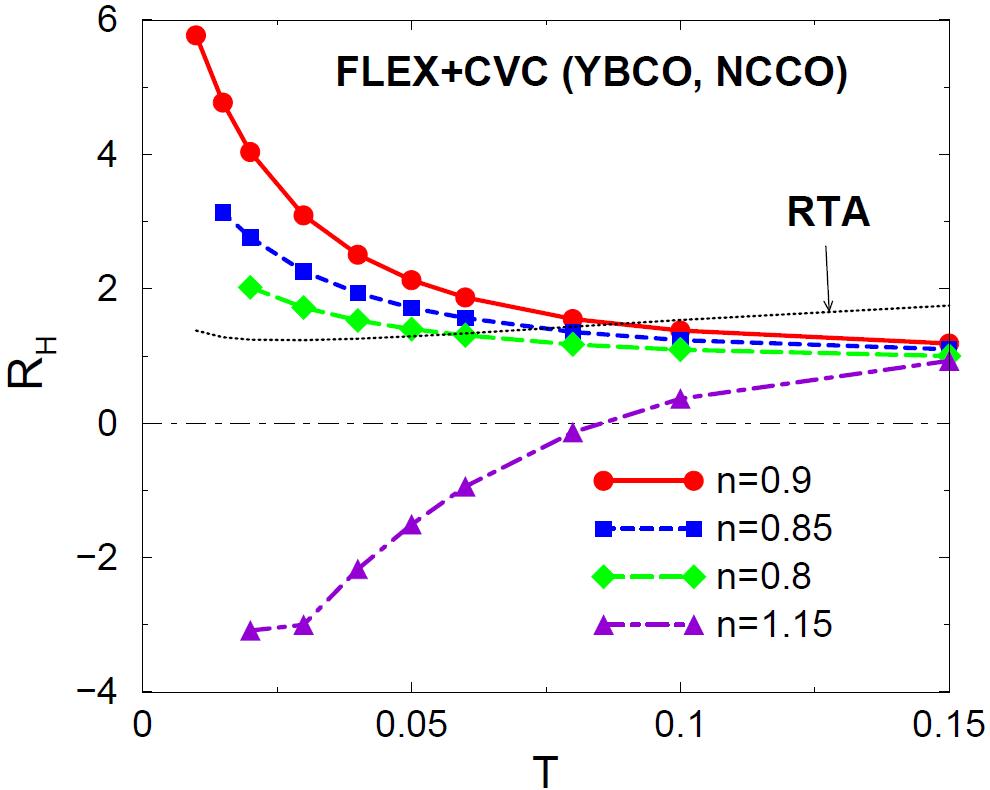Tranceport Phenomena
Novel quantum critical effects in transport phenomena

Curie-Weiss temperature dependence of Hall
coefficient RH induced by the current vertex
corrections. T=0.1 corresponds to 400K.
RH becomes negative for electron-doped case (n=1.10).
The superconducting transition temperature Tc in cuprate superconductors reaches ~160K. To understand the pairing mechanism, remarkable deviations from the Fermi liquid properties in conventional metals, called the non-Fermi liquid like states, have attracted great attention. The reason is that the high-Tc state originates from the non-Fermi liquid like normal states through the second-order phase transition.
For example, the Hall coefficient RH exhibits the Curie-Weiss temperature dependence for wide temperature and doping range, in highly contrast to the T-independent RH in conventional metals. Especially, RH in electron-doped cuprates exhibits negative values, irrespective of the fact that the topology of the Fermi surface is hole-like. Such strong deviation from conventional Fermi-liquid behavior in RH has been discussed very actively, as a possible strong evidence for the violation of Fermi liquid ground state.
To attach this problem, we developed the transport theory in strongly correlated metals, by focusing on the impact of the current vertex correction [1-4]. We revealed that the current vertex corrections give remarkable anomalous behaviors not only in RH, but also in magnetoresistance, thermoelectric power, and Nernst coefficient. Thus, anomalous transport phenomena in cuprates are satisfactorily understood as universal properties of the nearly antiferromagnetic metals in a unified way. In fact, theories in Refs. [1-4] are applicable for other nearly antiferromagnetic metals, such as heavy fermion CeMIn5 (M=Co, Rh, Ir) and organic superconductors κ-(BEDT-TTF). Recently, anomalous transport phenomena in Fe-based superconductors are satisfactorily explained [5].
We also studied novel quantum transport phenomena, such as spin Hall effect and anomalous Hall effect, by focusing on the impact of orbital degrees of freedom. We revealed that the giant Hall effects in 4d and 5d transition metals originates from the orbital Berry phase due to the orbital degrees of freedom and the spin-orbit interaction [4,6-9]. The theoretical prediction has been confirmed experimentally by Otani group (ISSP). The present mechanism also explains the large topological Hall effect in pyrochlore compounds Nd2Mo2O7 and coplanar antiferromagnetic metal Mn3Si [10,11].
[1] H. Kontani, K. Kanki, and K. Ueda, Phys. Rev. B 59, 14723 (1999).
[2] H. Kontani, Phys. Rev. Lett 89, 237003 (2002).
[3] H. Kontani, Rep. Prog. Phys. 71, 026501 (2008).
[4] H. Kontani, "Transport Phenomena in Strongly Correlated Fermi Liquids"
(Springer Berlin Heidelberg, Berlin, Heidelberg, 2013).
[5] S. Onari and H. Kontani, Phys. Rev. B 96, 094527 (2017).
[6] H. Kontani et al., Phys. Rev. Lett. 100, 096601 (2008).
[7] H. Kontani et al., Phys. Rev. Lett. 102, 016601 (2009).
[8] H. Kontani, J. Goryo, and D. S. Hirashima, Phys. Rev. Lett. 102, 086602 (2009).
[9] M. Morita et al., Phys. Rev. B 83, 174405 (2011).
[10] T Tomizawa, and H. Kontani, Phys. Rev. B 80, 100401(R) (2009).
[11] T. Tomizawa and H. Kontani, Phys. Rev. B 82, 104412 (2010).
